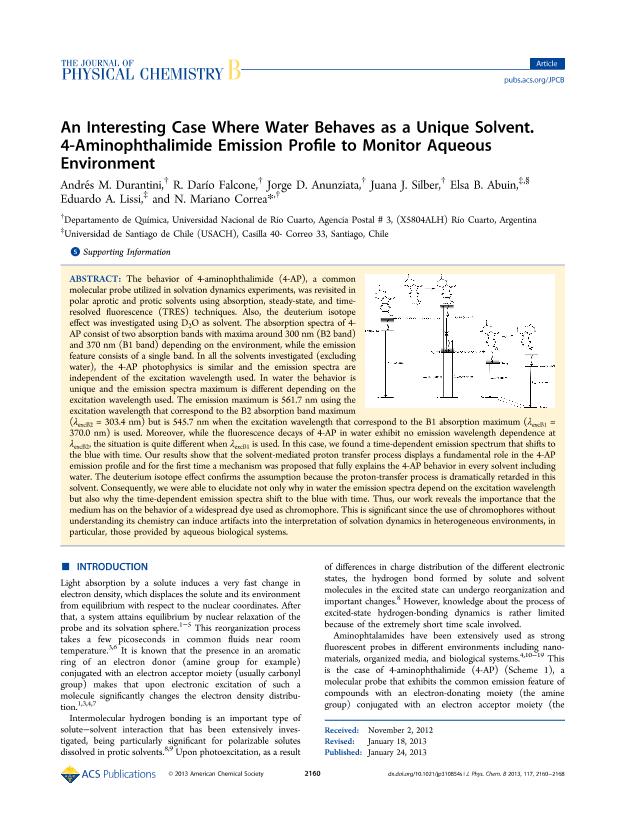Artículo
An interesting case where water behaves as a unique solvent: 4-aminophthalimide emission profile to monitor aqueous environment
Durantini, Andres Matías ; Falcone, Ruben Dario
; Falcone, Ruben Dario ; Anunziata, Jorge Daniel
; Anunziata, Jorge Daniel ; Abuin, Elsa B.; Lissi, Eduardo A.; Chessa, Juana Josefa
; Abuin, Elsa B.; Lissi, Eduardo A.; Chessa, Juana Josefa ; Correa, Nestor Mariano
; Correa, Nestor Mariano
 ; Falcone, Ruben Dario
; Falcone, Ruben Dario ; Anunziata, Jorge Daniel
; Anunziata, Jorge Daniel ; Abuin, Elsa B.; Lissi, Eduardo A.; Chessa, Juana Josefa
; Abuin, Elsa B.; Lissi, Eduardo A.; Chessa, Juana Josefa ; Correa, Nestor Mariano
; Correa, Nestor Mariano
Fecha de publicación:
01/2013
Editorial:
American Chemical Society
Revista:
Journal of Physical Chemistry B
ISSN:
1089-5647
Idioma:
Inglés
Tipo de recurso:
Artículo publicado
Clasificación temática:
Resumen
The behavior of 4-aminophthalimide (4-AP), a common molecular probe utilized in solvation dynamics experiments, was revisited in polar aprotic and protic solvents using absorption, steady-state, and timeresolved fluorescence (TRES) techniques. Also, the deuterium isotope effect was investigated using D2O as solvent. The absorption spectra of 4- AP consist of two absorption bands with maxima around 300 nm (B2 band) and 370 nm (B1 band) depending on the environment, while the emission feature consists of a single band. In all the solvents investigated (excluding water), the 4-AP photophysics is similar and the emission spectra are independent of the excitation wavelength used. In water the behavior is unique and the emission spectra maximum is different depending on the excitation wavelength used. The emission maximum is 561.7 nm using the excitation wavelength that correspond to the B2 absorption band maximum (λexcB2 = 303.4 nm) but is 545.7 nm when the excitation wavelength that correspond to the B1 absorption maximum (λexcB1 = 370.0 nm) is used. Moreover, while the fluorescence decays of 4-AP in water exhibit no emission wavelength dependence at λexcB2, the situation is quite different when λexcB1 is used. In this case, we found a time-dependent emission spectrum that shifts to the blue with time. Our results show that the solvent-mediated proton transfer process displays a fundamental role in the 4-AP emission profile and for the first time a mechanism was proposed that fully explains the 4-AP behavior in every solvent including water. The deuterium isotope effect confirms the assumption because the proton-transfer process is dramatically retarded in this solvent. Consequently, we were able to elucidate not only why in water the emission spectra depend on the excitation wavelength but also why the time-dependent emission spectra shift to the blue with time. Thus, our work reveals the importance that the medium has on the behavior of a widespread dye used as chromophore. This is significant since the use of chromophores without understanding its chemistry can induce artifacts into the interpretation of solvation dynamics in heterogeneous environments, in particular, those provided by aqueous biological systems.
Palabras clave:
4-Ap
,
Water
,
Photochemistry
Archivos asociados
Licencia
Identificadores
Colecciones
Articulos(CCT - CORDOBA)
Articulos de CTRO.CIENTIFICO TECNOL.CONICET - CORDOBA
Articulos de CTRO.CIENTIFICO TECNOL.CONICET - CORDOBA
Citación
Durantini, Andres Matías; Falcone, Ruben Dario; Anunziata, Jorge Daniel; Abuin, Elsa B.; Lissi, Eduardo A.; et al.; An interesting case where water behaves as a unique solvent: 4-aminophthalimide emission profile to monitor aqueous environment; American Chemical Society; Journal of Physical Chemistry B; 117; 7; 1-2013; 2160-2168
Compartir
Altmétricas



